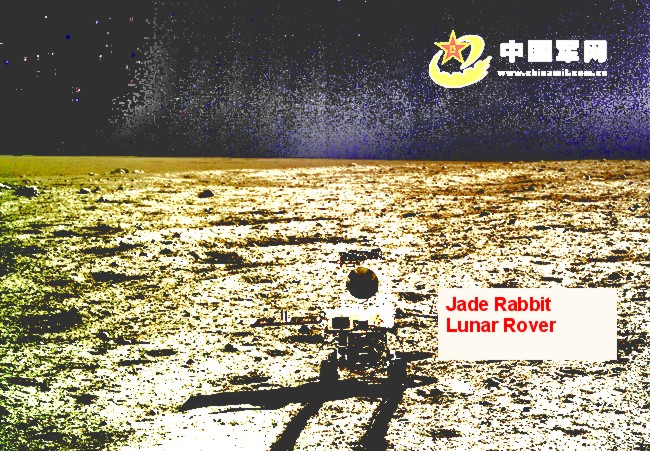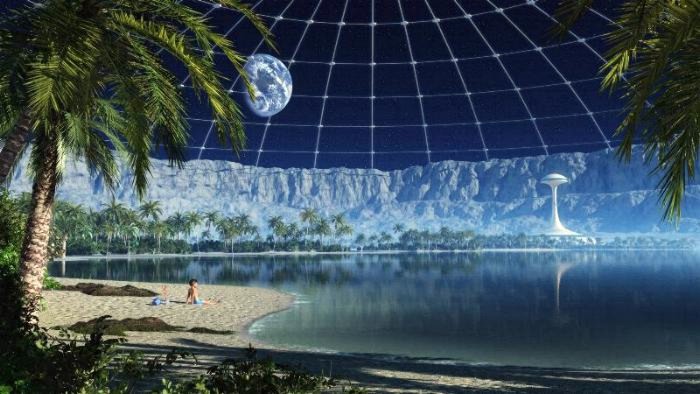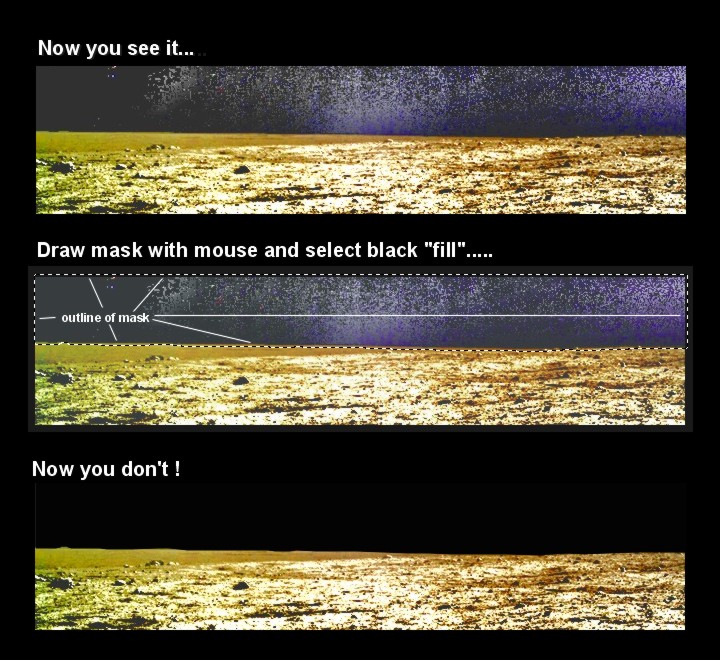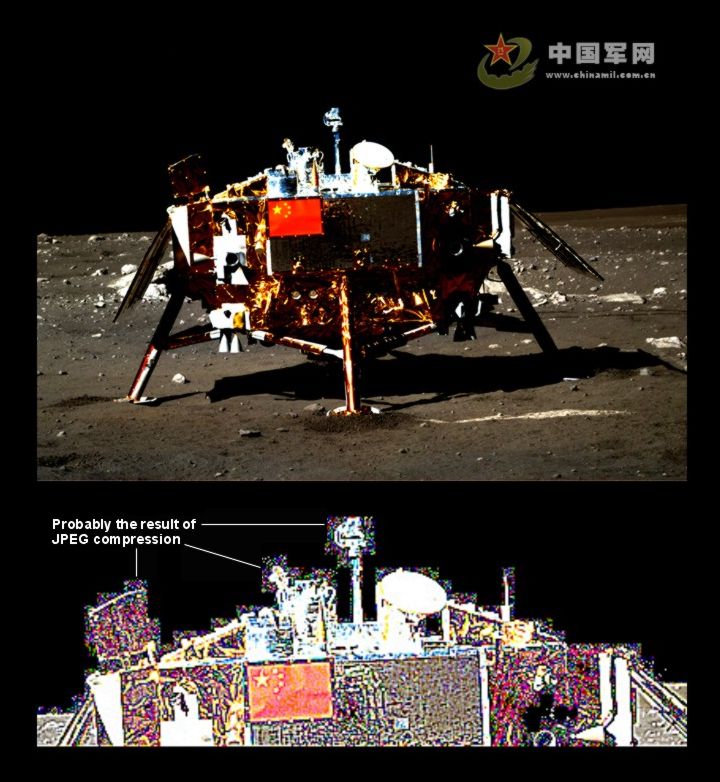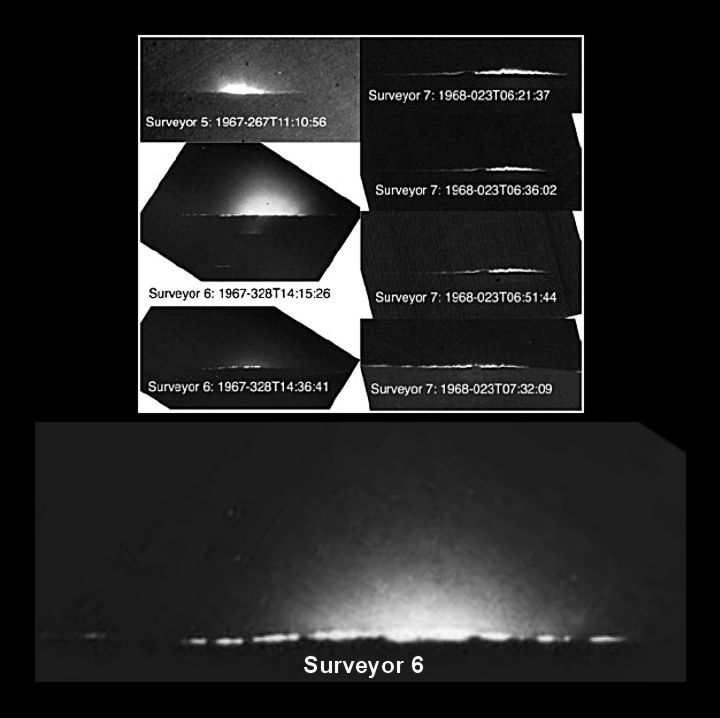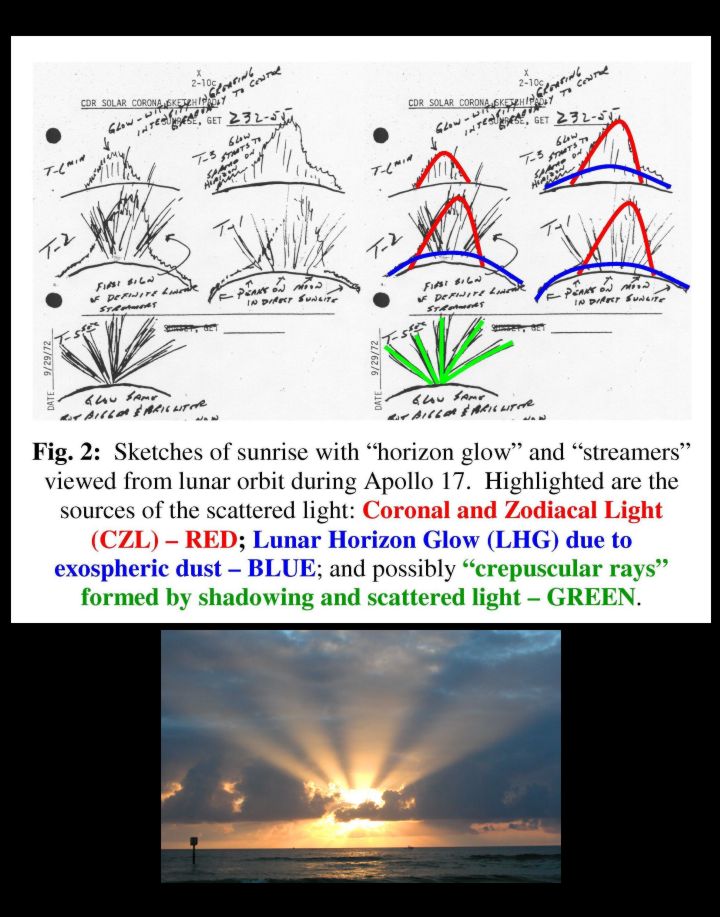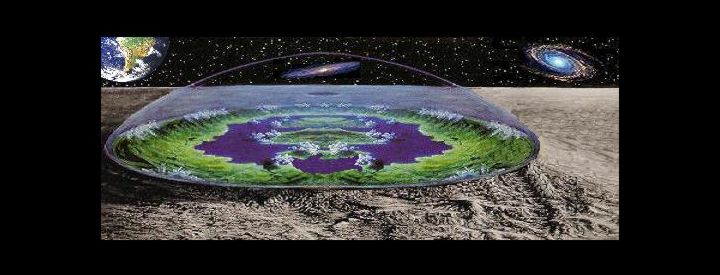|
Cydonia Quest
The Occasional Journal C
Entry No. 12 - 12th May 2014
The Art of Painting the Roses Red........and the Sky Black
Readers of the Enterprise Mission (TEM) website will have already read Richard Hoagland's latest article about anomalies in images sent back by China's Chang'e 3 mission to the Moon. When "gamma" brightening is applied to these images the normally black lunar sky appears to be filled with towering "stuff". (Part 1 of the TEM article can be read here).
This example shows sky anomalies that are apparently soaring above the horizon in front of the intrepid Jade Rabbit lunar rover. (The gamma, contrast and lightness have been greatly altered to show slight variations in the darkness of the sky in this image that would normally be invisible). It is notable that these anomalies are not seen in the dark shadow cast by the rover, which remains evenly black. So they might be more than just mere electronic "noise" in this particular image. C
c
Since at least the mid 1990's TEM has had a theory that there are the very residual remains of miles high bio-domes sitting on the lunar surface. These would be made of high tensile engineering glass. TEM has compiled a database of images taken from Moon orbit and from its surface, by many different lunar missions and by different countries, which apparently show the vestigial remains of these bio-domes. Previous TEM internet articles on this subject can be found here, here, here, here, here and here. However, the fullest exposition of TEM's evidence seems to be in Richard Hoagland and Mike Bara's book Dark Mission (here). C
c The author of Cydonia Quest has kept a "watching brief" on TEM's work about this subject, but has an "agnostic" stance about whether the proposed remnants of lunar domes actually exist or not. They are certainly a possible explanation for some of the Moon's greatest mysteries - of which more later on.
The "agnosticism" derives from the way the Moon domes evidence is subject to the "UFO problem". People argue about what UFOs are because UFOs never hang around to be sufficiently studied and verified. So there are countless images and reports of UFO anomalies, but no "killer" evidence for any specific one of them.
In TEM's Moon domes model the very vestigial remains of the proposed ruins would only be visible when the angle between the observer, the Sun and the glass structural elements are just right. Moreover, combining this limitation with the limited opportunity for observing any specific "dome" from the lunar surface or from orbit means that there is a shortage of cross verification. So there are many images of possible glass domes in TEM's database, but there doesn't seem to be much replicated evidence for any specific dome from varied sources.
C Looking More Closely at TEM's Latest Article
Among the data used in the TEM article are four images that were posted on the website of the People's Liberation Army. These can be found here and here.
(These were the first proper images published from the mission. At the time these PLA images were posted to the internet the only published Chang'e 3 pictures from the lunar surface were press photographs snapped of the "big screen" at the Mission Control).
The PLA images comprised three pictures of the Lander taken by the Jade Rabbit rover, and one picture taken of the Rover by the Lander. (The latter picture was used for the illustration above).
When these four PLA images are gamma brightened the picture taken of the Rover and one of the pictures taken of the Lander reveal anomalously lightened areas in the sky. The camera settings necessary to deal with the glare of the lunar surface mean that the stars can't be picked up and the sky should be pitch black in the images.
It is possible that the lighter patches are just some kind of electronic camera "noise" that is affecting both the camera on the Lander and the camera on the Jade Rabbit rover. This will be the main argument of TEM's critics against its interpretation of the sky anomalies.
However, it is surprising that only two of the PLA images are affected by this "noise" - or from TEM's alternative stand point, only two are showing ruins of glass domes.
One possibility is that the two PLA images that have a perfectly black sky have been tampered with. Such editing might have arisen if in these images there were lighter patches visible in the sky, even when the pictures were processed with normal brightness and contrast. Of course the lunar sky in these pictures is supposed to be pitch black. In order to simply "save face" or as part of a cover-up, the Chinese might have just censored visible anomalies.
If you're the sort of person who thinks roses should be red and the lunar sky black, then this is very easy to achieve. The illustration below shows how the anomalies in the first picture in this article can be "put right". It took about two minutes to do and - "Hey! Presto!" - the problem is solved.
So, is there actually any evidence that the above process was applied to the two PLA "black sky" images?
Well, when Cydonia Quest first gamma brightened these images there seemed to be a roughly drawn "mask" around the outline of the Chang'e 3 Lander and horizon against the sky. This is shown in the next illustration.
However, further experimentation by Cydonia Quest with other images strongly suggests that this is just a "bleed" effect produced by JPEG compression.
We would also expect any image censoring to have been done to a more undetectable standard, with a "mask" that fitted the Lander's outline perfectly. The "black sky" images could well have been tampered with, but this researcher wouldn't know how to uncover professional censorship.
Scientific Fact: the Lunar Sky does Glow
There are actually some accepted scientific mysteries concerning the lunar sky for which TEM's massive glass ruins are one possible explanation.
Ever since astronomers began to observe the Moon with good telescopes they've been noting Transient Lunar Phenomena (TLP). Very brief flashes of light seen on the Moon are most likely the result of meteorite impacts, but other phenomena have been harder to explain.
Certain parts of the Moon are occasionally seen to brighten up and change colour for up to hours at a time. The most common colours for these glowing "clouds" or "hazes" are red and violet. Sometimes areas of the Moon exhibit transient darkening, as if something is throwing a shadow.
Historically, the most popular explanation for TLP has been that they are the result of large eruptions of gas from beneath the Moon's crust. In terms of TEM's bio-domes theory the brightening and colour changes would be the result of light reflecting and refracting off the remains of the glass domes in favourable conditions. The darkenings of the surface could be faint shadows thrown by the proposed "glass ruins". c Evidence from the Space Age
It wasn't until the space age that more hard edged observations were made of light being refracted around an airless lunar sky. Before the Apollo missions the Surveyor 5, 6, 7 - and probably Surveyor 1 - lunar landers observed an inexplicable bright twilight in the post sunset period.
After the Sun and its corona (the glowing plasma atmosphere) had set, the horizon was seen to light up brightly as "something" refracted the sunlight from below the limb of the Moon. This only happens on Earth because of its refractive atmosphere, which the Moon doesn't have. The following illustration displays a collection of the horizon glows observed by the Surveyor landers.
Whilst in orbit around the Moon the astronauts of Apollo missions 8, 10, 15 and 17 also noted this horizon glow on the lunar limb before the Sun set or rose. They also observed "streamers" of light or "twilight rays" radiating from below the horizon where the Sun would be. On Earth these rays are formed when the Sun shines through hazy air and intervening clouds or ground features create partial shadows.
The following illustration shows a page from the Apollo 17 notebook describing the unexpected horizon glow and "twilight" rays observed by that mission. Only the glow of the Sun's corona and the very faint light of the Zodiacal Light could be expected. (The Zodiacal Light is a very faint glow created along the plane of the Solar System by reflective dust particles orbiting the Sun).
In the TEM theory the Lunar Horizon Glow would be due to the general refraction of the many "glass ruins" that are proposed to be on the Moon's surface. The "twilight rays" would be due to the Sun sitting directly behind a particularly tall and refractive bio-dome relic.
The most popular natural explanation for the horizon glows seen by the Surveyor landers is that dust was being electrostatically levitated up to three feet above the lunar surface - and that this continuous cloud of dust was refracting sunlight from below the horizon.
The idea of electrostatic levitation of lunar dust was first mooted by science fiction writer Hal Clement in 1956. The theory is that solar radiation knocks electrons off the surface atoms in moon-dust, leaving them with a positive electric charge. Particles with the same electric charge repel each other, so causing dust to leap off the lunar surface......in theory anyway. This electrostatic "levitation" is the same reason why our hair stands on end if we comb/brush it too much. The hairs are being repelled from one another by the static electricity.
Despite the theory's popularity it must be noted that levitating moon-dust has never been observed directly by any lander, robotic rover or astronaut that has gone to the Moon.
The Apollo astronaut and geologist Harrison Schmitt has always been sceptical about the electrostatic levitation theory.
"My concern about levitated dust has always been that levitation, if it occurs at all, probably has to be a one-way trip off the moon … because many flat rock surfaces are essentially free of very fine dust, as I personally witnessed on Apollo 17."
Schmitt thinks that if dust had been levitated and then dropped again, the rock surfaces should be covered with such dust.
It also appears that no-one has been able to replicate or mathematically model a situation in which dust lifts off the surface and stays suspended for long periods. So the physics as currently understood does not support the theory.
Fountains of Delusion?
The theory of electrostatic levitation previously described is not sufficient to explain what the Apollo astronauts saw from orbit. In order for them to see an appreciable horizon glow and the "twilight rays" the proposed dust clouds must levitate many miles above the Moon's surface.
In 2005 NASA scientists Timothy J. Stubbs, Richard R. Vondrak, and William M. Farrell published a paper for a model of electrostatic "dust fountains" that were blasting dust up to 62 miles into the lunar sky. (See here).
In this model smaller dust grains are ejected electrostatically from the surface with such speed that they travel miles into the sky before falling again. This rising and falling of dust grains is continuous, creating very high and long lasting dust clouds.
In order to settle the controversies surrounding the levitation theories NASA launched its Lunar Atmosphere and Dust Environment Explorer (LADEE) mission to the Moon in September 2013. LADEE's mission was to examine any gases, vapours and dust to be found in the lunar sky. It was put into an orbit that slowly spiralled down to only a few miles above the lunar surface before being crashed there in April 2014.
According to Rick Elphic, the LADEE project scientist, if the aerial dust is there LADEE's instruments were sensitive enough to detect it.
At the time of finishing this article, the only reported detections of lunar dust by LADEE were short bursts linked to meteorite impacts.
Indeed, this press release states LADEE never detected dust in sufficient quantities to explain what the Apollo astronauts saw - "....the very low dust densities that LADEE's Lunar Dust Experiment (LDEX) measured should not produce such a sunrise glow – there were just too few particles along the line of sight to scatter measurable light."
Despite their popularity, for the present, the "dust fountains" model and electrostatic theories of dust levitation appear to be "dead".
The lunar horizon glows and "twilight rays" still remain unexplained by natural models at this time.
This is something that TEM will no doubt bring up in subsequent articles about its ruined bio-domes theory.
c µ Click this "Stargate" to return to Journal main page µ Return to the main Mars page µ Return to the Cydonia Quest main page c
|
